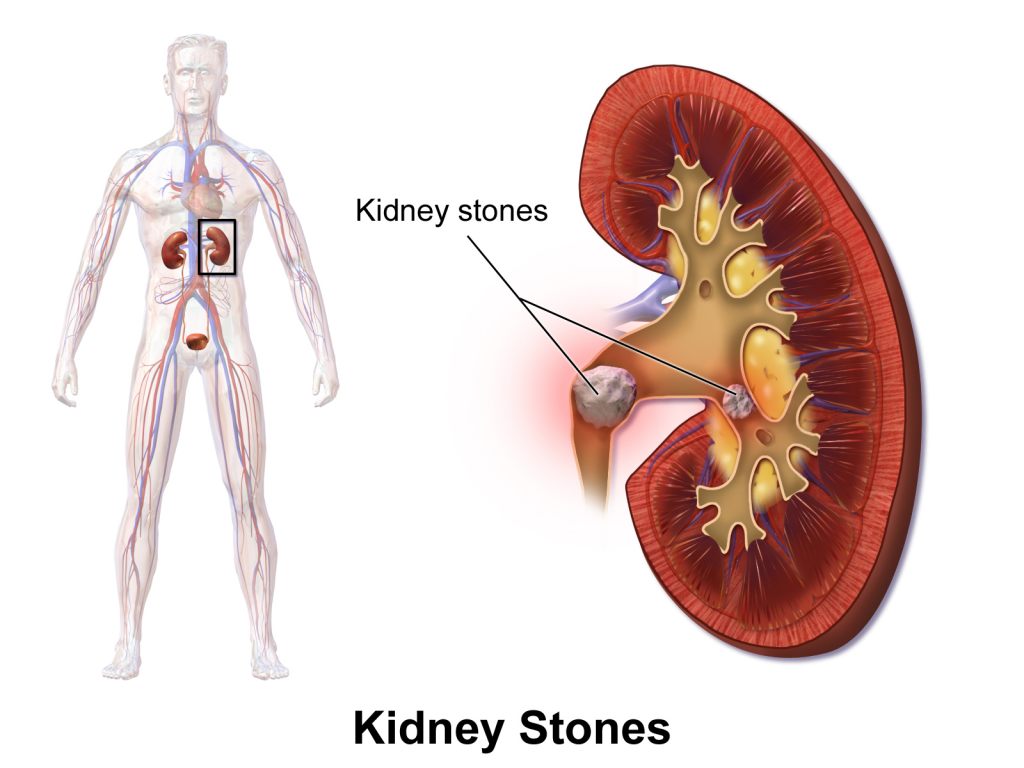Learn all about Kidney Stones Symptoms, Causes and Treatment!
Kidney stones (renal lithiasis) may be caused by some infection in the kidney such as pyelitis or they may result from stagnation of the urine in the kidney because of obstruction in its passage from kidney to the bladder. This obstruction may be caused by back pressure from an obstruction at the bladder outlet rather than by anything wrong in the bladder itself or in the ureter.Abnormalities in the metabolism of certain body’s chemical substances may contribute to this condition. Notable among such metabolic disorders is gout, in which there is a considerable tendency to the formation of kidney stones.Kidney stones are made up of minerals and acid salts.Kindney stones can affect any part of your urinary tract.Most of the time stones formed when urine becomes concentrated allowing minerals to crystallize and stick together.
Symptoms of kidney stones
During early phase kidney stone does produce any major sign and symptoms.But when it becomes hard and larger in size due to deposition of minerals and acid salts following sign and symptoms may appear
- Persistent urge to urinate
- Fever and chills
- Cloudy or foul smelling urine
- Pain on urination
- Intermittent attacks of pain
- Severe pain in the side and back
- Dribbling of urine
Causes of kidney stones
It is thought that improperly balanced diets or deficiencies of certain vitamins favor the formation and growth of kidney stones. The various chemical salts in the urine, especially the phosphates and the urates, may be precipitated and form the beginning of one or more stones. Such precipitation would be promoted by concentration of the urine such as may result from drinking too little water.If the stones are small, they may pass down the ureters and be voided from the bladder without the person’s knowledge. This is probably what happens to many kidney stones. If a stone remains in the pelvis of a kidney, it will steadily increase in size.
A large stone may lie unsuspected in a kidney pelvis for years. The symptoms of a stone in a kidney pelvis may be trifling. In fact, a kidney may be entirely destroyed before the victim has sufficient distress to persuade him to consult a physician. Usually, however, there is increased frequency of urination, especially associated with exertion or riding over rough roads. There may be vague pains and soreness through the upper back and side. If a ureter becomes blocked, there may be much pain, chills, and fever.
Treatment of kidney stones
Treatment of kidney stones vary depending upon the cause and type of kidney stone.Most of the kidney stones do not require invasive treatment.Here are some treatment option that can be followed to treat kidney stones.
Drinking water
Drinking as much as 2 to 3 quarts (1.9 to 2.8 liters) is very beneficial in flushing out small size kidney stone without any surgical intervention.This is the most easy way to flush out small size kidney stone but sometimes it does not work due to certain pathological conditions.
Pain relievers
Kidney stone may cause swelling or irritation in the internal lining of urinary tract and in some cases it damages the nephrons which are key components of kidney. For this purpose NSAIDS are used to relieve mild to moderate pain such as ibuprofen (Advil, Motrin, others) acetaminophen (Tylenol, others) or naproxen sodium (Aleve).
sound waves to break up stones
This method is only effective when size of kidney stone is small.For this purpose your health care provider may recommend a procedure called extra-corporeal shock wave lithotripsy (SWL).SWL uses sound waves to create strong vibrations (shock waves) that break the stones into tiny pieces that can be passed in your urine. The process takes about 40-65 minutes depending upon the size of kidney stone.
Surgery
If extra-corporeal shock wave lithotripsy (SWL) is not suitable due to larger size of kidney stone then your health care provider may suggest per-cutaneous nephrolithotomy This method is used to remove kidney stone using telescopes and instruments inserted through a small incision in your back.For this purpose general anesthesia is required to perform this procedure smoothly.
 Health & Care Information
Health & Care Information 


